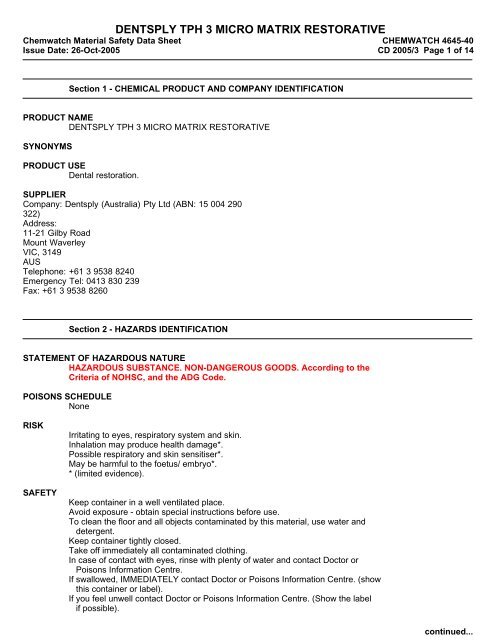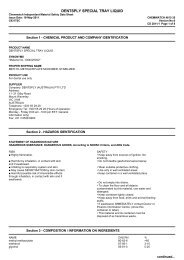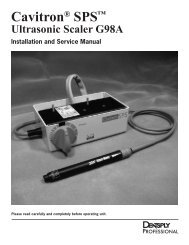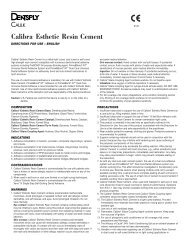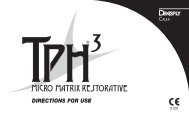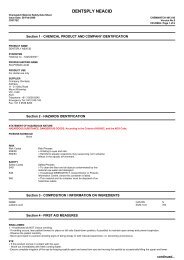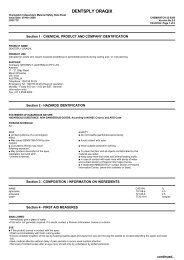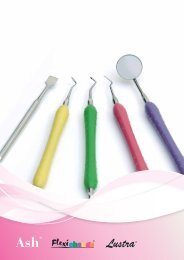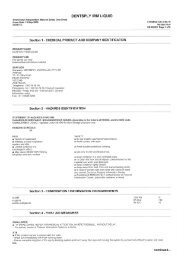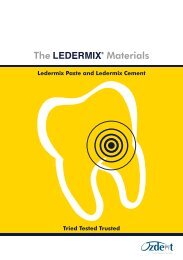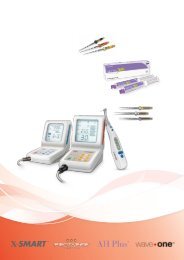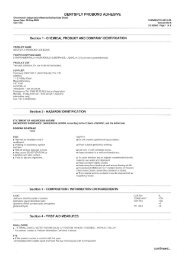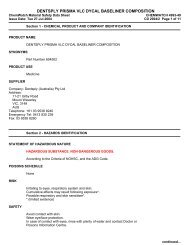dentsply tph 3 micro matrix restorative
dentsply tph 3 micro matrix restorative
dentsply tph 3 micro matrix restorative
You also want an ePaper? Increase the reach of your titles
YUMPU automatically turns print PDFs into web optimized ePapers that Google loves.
DENTSPLY TPH 3 MICRO MATRIX RESTORATIVE<br />
Chemwatch Material Safety Data Sheet CHEMWATCH 4645-40<br />
Issue Date: 26-Oct-2005 CD 2005/3 Page 1 of 14<br />
Section 1 - CHEMICAL PRODUCT AND COMPANY IDENTIFICATION<br />
PRODUCT NAME<br />
DENTSPLY TPH 3 MICRO MATRIX RESTORATIVE<br />
SYNONYMS<br />
PRODUCT USE<br />
Dental restoration.<br />
SUPPLIER<br />
Company: Dentsply (Australia) Pty Ltd (ABN: 15 004 290<br />
322)<br />
Address:<br />
11-21 Gilby Road<br />
Mount Waverley<br />
VIC, 3149<br />
AUS<br />
Telephone: +61 3 9538 8240<br />
Emergency Tel: 0413 830 239<br />
Fax: +61 3 9538 8260<br />
Section 2 - HAZARDS IDENTIFICATION<br />
STATEMENT OF HAZARDOUS NATURE<br />
HAZARDOUS SUBSTANCE. NON-DANGEROUS GOODS. According to the<br />
Criteria of NOHSC, and the ADG Code.<br />
POISONS SCHEDULE<br />
None<br />
RISK<br />
SAFETY<br />
Irritating to eyes, respiratory system and skin.<br />
Inhalation may produce health damage*.<br />
Possible respiratory and skin sensitiser*.<br />
May be harmful to the foetus/ embryo*.<br />
* (limited evidence).<br />
Keep container in a well ventilated place.<br />
Avoid exposure - obtain special instructions before use.<br />
To clean the floor and all objects contaminated by this material, use water and<br />
detergent.<br />
Keep container tightly closed.<br />
Take off immediately all contaminated clothing.<br />
In case of contact with eyes, rinse with plenty of water and contact Doctor or<br />
Poisons Information Centre.<br />
If swallowed, IMMEDIATELY contact Doctor or Poisons Information Centre. (show<br />
this container or label).<br />
If you feel unwell contact Doctor or Poisons Information Centre. (Show the label<br />
if possible).<br />
continued...
DENTSPLY TPH 3 MICRO MATRIX RESTORATIVE<br />
Chemwatch Material Safety Data Sheet CHEMWATCH 4645-40<br />
Issue Date: 26-Oct-2005 CD 2005/3 Page 2 of 14<br />
Section 3 - COMPOSITION / INFORMATION ON INGREDIENTS<br />
NAME CAS RN %<br />
soluble amorphous glass wool 65997-17-3.
DENTSPLY TPH 3 MICRO MATRIX RESTORATIVE<br />
Chemwatch Material Safety Data Sheet CHEMWATCH 4645-40<br />
Issue Date: 26-Oct-2005 CD 2005/3 Page 3 of 14<br />
Section 5 - FIRE FIGHTING MEASURES<br />
FIRE FIGHTING<br />
- Alert Fire Brigade and tell them location and nature of hazard.<br />
- Wear breathing apparatus plus protective gloves.<br />
- Prevent, by any means available, spillage from entering drains or water<br />
course.<br />
- Use water delivered as a fine spray to control fire and cool adjacent area.<br />
- Avoid spraying water onto liquid pools.<br />
- Do not approach containers suspected to be hot.<br />
- Cool fire exposed containers with water spray from a protected location.<br />
- If safe to do so, remove containers from path of fire.<br />
FIRE/EXPLOSION HAZARD<br />
- Non combustible.<br />
- Not considered a significant fire risk, however containers may burn.<br />
FIRE INCOMPATIBILITY<br />
Avoid contamination with oxidising agents i.e. nitrates, oxidising acids,<br />
chlorine bleaches, pool chlorine etc. as ignition may result.<br />
HAZCHEM<br />
None<br />
Personal Protective Equipment<br />
Gas tight chemical resistant suit.<br />
Limit exposure duration to 1 BA set30 mins.<br />
Section 6 - ACCIDENTAL RELEASE MEASURES<br />
EMERGENCY PROCEDURES<br />
MINOR SPILLS<br />
- Remove all ignition sources.<br />
- Clean up all spills immediately.<br />
- Avoid breathing vapours and contact with skin and eyes.<br />
- Control personal contact by using protective equipment.<br />
- Contain and absorb spill with sand, earth, inert material or vermiculite.<br />
- Wipe up.<br />
- Place in a suitable labelled container for waste disposal.<br />
MAJOR SPILLS<br />
Moderate hazard.<br />
- Clear area of personnel and move upwind.<br />
- Alert Fire Brigade and tell them location and nature of hazard.<br />
- Wear breathing apparatus plus protective gloves.<br />
- Prevent, by any means available, spillage from entering drains or water<br />
course.<br />
- No smoking, naked lights or ignition sources.<br />
- Increase ventilation.<br />
- Stop leak if safe to do so.<br />
- Contain spill with sand, earth or vermiculite.<br />
- Collect recoverable product into labelled containers for recycling.<br />
- Absorb remaining product with sand, earth or vermiculite.<br />
- Collect solid residues and seal in labelled drums for disposal.<br />
- Wash area and prevent runoff into drains.<br />
continued...
DENTSPLY TPH 3 MICRO MATRIX RESTORATIVE<br />
Chemwatch Material Safety Data Sheet CHEMWATCH 4645-40<br />
Issue Date: 26-Oct-2005 CD 2005/3 Page 4 of 14<br />
Section 6 - ACCIDENTAL RELEASE MEASURES<br />
- If contamination of drains or waterways occurs, advise emergency services.<br />
EMERGENCY EXPOSURE LIMITS<br />
Material Revised IDLH Revised IDLH<br />
Value (ppm) Value (mg/m3)<br />
Silica, amorphous 3,000<br />
Titanium dioxide 5,000<br />
EMERGENCY RESPONSE PLANNING GUIDELINES (ERPG)<br />
The maximum airborne concentration below which it is believed that nearly all<br />
individuals could be exposed for up to one hour WITHOUT experiencing or developing<br />
life-threatening health effects is:<br />
triethylene glycol dimethacrylate<br />
silica amorphous, fumed<br />
silica, dimethylsiloxane treated<br />
titanium dioxide<br />
500 mg/m³<br />
500 mg/m³<br />
500 mg/m³<br />
500 mg/m³<br />
irreversible or other serious effects or symptoms which could<br />
impair an individual's ability to take protective action is:<br />
triethylene glycol dimethacrylate<br />
50 mg/m³<br />
silica amorphous, fumed<br />
100 mg/m³<br />
silica, dimethylsiloxane treated<br />
125 mg/m³<br />
titanium dioxide<br />
15 mg/m³<br />
other than mild, transient adverse effects<br />
without perceiving a clearly defined odour is:<br />
triethylene glycol dimethacrylate<br />
silica amorphous, fumed<br />
silica, dimethylsiloxane treated<br />
titanium dioxide<br />
30 mg/m³<br />
6 mg/m³<br />
15 mg/m³<br />
15 mg/m³<br />
The threshold concentration below which most people.<br />
will experience no appreciable risk of health effects:<br />
triethylene glycol dimethacrylate<br />
10 mg/m³<br />
silica amorphous, fumed<br />
2 mg/m³<br />
silica, dimethylsiloxane treated<br />
6 mg/m³<br />
titanium dioxide<br />
15 mg/m³<br />
American Industrial Hygiene Association (AIHA)<br />
Ingredients considered according exceed the following cutoffs<br />
Very Toxic (T+) >= 0.1% Toxic (T) >= 3.0%<br />
R50 >= 0.25% Corrosive (C) >= 5.0%<br />
R51 >= 2.5%<br />
else >= 10%<br />
where percentage is percentage of ingredient found in the mixture<br />
Personal Protective Equipment advice is contained in Section 8 of the MSDS.<br />
Section 7 - HANDLING AND STORAGE<br />
PROCEDURE FOR HANDLING<br />
- Avoid all personal contact, including inhalation.<br />
continued...
DENTSPLY TPH 3 MICRO MATRIX RESTORATIVE<br />
Chemwatch Material Safety Data Sheet CHEMWATCH 4645-40<br />
Issue Date: 26-Oct-2005 CD 2005/3 Page 5 of 14<br />
Section 7 - HANDLING AND STORAGE<br />
- Wear protective clothing when risk of exposure occurs.<br />
- Use in a well-ventilated area.<br />
- Prevent concentration in hollows and sumps.<br />
- DO NOT enter confined spaces until atmosphere has been checked.<br />
- Avoid smoking, naked lights or ignition sources.<br />
- Avoid contact with incompatible materials.<br />
- When handling, DO NOT eat, drink or smoke.<br />
- Keep containers securely sealed when not in use.<br />
- Avoid physical damage to containers.<br />
- Always wash hands with soap and water after handling.<br />
- Work clothes should be laundered separately.<br />
- Use good occupational work practice.<br />
- Observe manufacturer's storing and handling recommendations.<br />
- Atmosphere should be regularly checked against established exposure standards<br />
to ensure safe working conditions.<br />
DO NOT allow clothing wet with material to stay in contact with skin.<br />
SUITABLE CONTAINER<br />
Packaging as recommended by manufacturer.<br />
STORAGE INCOMPATIBILITY<br />
Avoid reaction with oxidising agents.<br />
STORAGE REQUIREMENTS<br />
- Store in original containers.<br />
- Keep containers securely sealed.<br />
- No smoking, naked lights or ignition sources.<br />
- Store in a cool, dry, well-ventilated area.<br />
- Store away from incompatible materials and foodstuff containers.<br />
- Protect containers against physical damage and check regularly for leaks.<br />
- Observe manufacturer's storing and handling recommendations.<br />
Protect from light.<br />
Section 8 - EXPOSURE CONTROLS / PERSONAL PROTECTION<br />
EXPOSURE CONTROLS<br />
Source Material TWA TWA STEL STEL Peak Peak<br />
ppm mg/m³ ppm mg/m³ ppm mg/m³<br />
_________________________ ________________ _____ _____ _____ _____ _____ _____<br />
Australian Exposure Titanium dioxide 10<br />
Standards<br />
Australian Exposure Silica - 2<br />
Standards<br />
Amorphous, Fume<br />
(thermally<br />
generated)<br />
(respirable<br />
dust) (g)<br />
Australian Exposure Silica - 2<br />
Standards<br />
Amorphous, Fume<br />
(thermally<br />
generated)<br />
(respirable<br />
dust) (g)<br />
Australian Exposure Silica - 2<br />
continued...
DENTSPLY TPH 3 MICRO MATRIX RESTORATIVE<br />
Chemwatch Material Safety Data Sheet CHEMWATCH 4645-40<br />
Issue Date: 26-Oct-2005 CD 2005/3 Page 6 of 14<br />
Section 8 - EXPOSURE CONTROLS / PERSONAL PROTECTION<br />
Standards<br />
Amorphous, Fume<br />
(thermally<br />
generated)<br />
(respirable<br />
dust) (g)<br />
Australian Exposure Titanium dioxide 10<br />
Standards<br />
No data available: Dentsply TPH 3 Micro Matrix Restorative as (CAS: 65997-17-3.) / (CAS: 65997-18-4) / (CAS: 2444<br />
No data available: soluble amorphous glass wool as (CAS: 65997-17-3)<br />
No data available: frits chemical as (CAS: 65997-18-4)<br />
No data available: 2,2-bis[4-(2-methacryloxy)ethoxy)phenyl]propane as (CAS: 24448-20-2)<br />
No data available: triethylene glycol dimethacrylate as (CAS: 109-16-0)<br />
No data available: silica amorphous, fumed as (CAS: 60842-32-2)<br />
No data available: silica, dimethylsiloxane treated as (CAS: 67762-90-7)<br />
Not available. Refer to individual constituents.<br />
EXPOSURE STANDARDS FOR MIXTURE<br />
"Worst Case" computer-aided prediction of spray/ mist or fume/ dust components<br />
and concentration:<br />
"Worst Case" computer-aided prediction of spray/ mist or fume/ dust components<br />
and concentration:<br />
Composite Exposure Standard for Mixture (TWA) :2.0784 mg/m³.<br />
"Worst Case" computer-aided prediction of spray/ mist or fume/ dust components<br />
and concentration:<br />
Composite Exposure Standard for Mixture (TWA) (mg/m³):<br />
Operations which produce a spray/mist or fume/dust, introduce particulates to<br />
the breathing zone.<br />
If the breathing zone concentration of ANY of the components listed below is<br />
exceeded, "Worst Case" considerations deem the individual to be overexposed.<br />
Component Breathing Zone ppm Breathing Zone mg/m³ Mixture Conc (%).<br />
Component Breathing Zone Mixture Conc<br />
(mg/m³) (%)<br />
soluble amorphous glass wool 1.9608 50.0<br />
silica amorphous, fumed 0.1176 3.0<br />
INGREDIENT DATA<br />
SOLUBLE AMORPHOUS GLASS WOOL:<br />
ES TWA: 0.5 respirable fibres per millilitre of air (f/mL) for synthetic<br />
mineral fibres SMF (MMMF); concentration to be determined in accordance<br />
with the NOH&S Commission's "Membrane Filter Method for the Estimation of<br />
Airborne Synthetic Fibres"<br />
ES TWA: 2 mg/m³ inspirable dust as determined in accordance with<br />
Australian Standard AS 3640<br />
TLV TWA: 1 f/cc A3 (respirable glass wool fibres, length >5um; aspect<br />
ratio >=3:1**)<br />
** - as determined by the membrane filter method at 400-450X magnification<br />
(4-mm objective) phase contrast illumination.<br />
CAUTION: This substance has been classified by the ACGIH as A3 Animal Carcinogen<br />
(at relatively high doses).<br />
FRITS CHEMICAL:<br />
The wide-ranging effects of antimony compounds have made it difficult to<br />
recommend an exposure standard which characterises the toxicology of these<br />
substances. One criteria, reflecting the irritant properties of antimony<br />
continued...
DENTSPLY TPH 3 MICRO MATRIX RESTORATIVE<br />
Chemwatch Material Safety Data Sheet CHEMWATCH 4645-40<br />
Issue Date: 26-Oct-2005 CD 2005/3 Page 7 of 14<br />
Section 8 - EXPOSURE CONTROLS / PERSONAL PROTECTION<br />
pentachloride, produced a calculated value of 5.0 mg/m³ (as antimony), which on<br />
the basis of experience was felt to be too high but did act as an "out-rider".<br />
The present value reflects this thinking.<br />
Based on a study in which the threshold for minimum increase in bone density due<br />
to fluoride exposure was 3.38 mg/m³ (as fluoride), the present TLV-TWA has been<br />
adopted to prevent irritant effects and disabling bone changes. There is also<br />
support for the proposition that occupational exposure below the TLV will have<br />
no adverse effect on pregnant women or off-spring. IARC has classified fluorides<br />
in drinking water as Group 3 carcinogens; i.e. Not classifiable as to its<br />
carcinogenicity to humans. Equivocal evidence of carcinogenic activity<br />
(osteosarcoma) has been found in male rats administered sodium fluoride in<br />
drinking water. (0-175 ppm) Evidence was not found in female rats or in male or<br />
female mice.<br />
The lead concentration in air is to be maintained so that the lead concentration<br />
in workers' blood remains below 0.060 mg/100 g of whole blood. The recommended<br />
TLV-TWA has been derived following a review of reports of adverse effects on<br />
reproduction, blood-pressure and other end-points of toxicity. A particular<br />
focus was an assessment of pre-natal blood lead (PbB) levels and post-natal<br />
cognitive levels. The fact that lead is a cumulative toxicant which can produce<br />
subtle, persistent and apparently permanent effects in the off-spring of lead<br />
exposed women is of particular concern. A current view holds that the<br />
identification of the PbB levels, that are protective during a working lifetime,<br />
is a necessary prerequisite in the recommendation of the TLV because PbB values,<br />
rather than workplace air lead concentrations, are more clearly related to<br />
adverse health effects.<br />
(see Biological Exposure Index - BEI - in "Advice to Doctor".).<br />
A number of studies have shown that susceptibility to the effects of manganese<br />
at or about 1 - 5 mg/m³ (TWA) can lead to clinical manifestations of manganism<br />
or more commonly to the development of indicators of sub-clinical manganism<br />
(e.g. hand tremor, exaggerated reflexes, short-term memory deficits, poor<br />
psychomotor performance). Controlling long-term exposure to the recommended ES<br />
TWA level or below should provide protection for those individuals susceptible<br />
to neurological effects of prolonged exposure.<br />
NOTE: Detector tubes for nickel, measuring in excess of 0.25 mg/m³ (as Ni) are<br />
commercially available.<br />
Use control measures / protective gear to avoid personal contact. Animal<br />
inhalation studies with insoluble nickel dusts (other than nickel sulfide) at<br />
concentrations of 1 to 3 mg/m³ show no difference in respiratory cancer between<br />
exposed and control animals.<br />
These studies do not provide evidence that there is no excess risk of lung and<br />
nasal cancer - in view of limited exposure data and the absence of guidance for<br />
a TLV based on epidemiological studies of nickel induced respiratory tract<br />
cancer, it has been necessary to incorporate the results of animal studies that<br />
have demonstrated the production of pulmonary pathology. These studies have<br />
shown consistent pulmonary damage following inhalation of 0.1 to 1 mg/m³<br />
insoluble inorganic nickel compounds. Individuals who may be hypersusceptible or<br />
otherwise unusually responsive to industrial chemicals may not be adequately<br />
protected against adverse health effects from nickel or its compounds at<br />
concentrations below the recommended or proposed TLV.<br />
OSHA concluded that the recommended TLV-TWA and STEL would protect workers from<br />
any significant risk of pulmonary effects. NIOSH conclude that a separate limit<br />
should be considered for zirconium tetrachloride (because of the irritancy of<br />
hydrogen chloride derived from hydrolysis). This was based on a 60-day<br />
inhalation study at 6 mg/m³ zirconium tetrachloride which found an increase in<br />
mortality of rats and guinea pigs due to respiratory infection and reductions of<br />
borderline statistical significance in circulating hemoglobin and erythrocyte<br />
continued...
DENTSPLY TPH 3 MICRO MATRIX RESTORATIVE<br />
Chemwatch Material Safety Data Sheet CHEMWATCH 4645-40<br />
Issue Date: 26-Oct-2005 CD 2005/3 Page 8 of 14<br />
Section 8 - EXPOSURE CONTROLS / PERSONAL PROTECTION<br />
counts in dogs.<br />
2,2-BIS[4-(2-METHACRYLOXY)ETHOXY)PHENYL]PROPANE:<br />
CEL TWA: 1 mg/m³ [compare WEEL-TWA* for multifunctional acrylates (MFAs)]<br />
Exposure to MFAs has been reported to cause contact dermatitis in humans and<br />
serious eye injury in laboratory animals. Exposure to some MFA-resin containing<br />
aerosols has also been reported to cause dermatitis. As no assessment of the<br />
possible effects of long-term exposure to aerosols was found, a conservative<br />
Workplace Environmental Exposure Level (WEEL) was suggested by the American<br />
Industrial Hygiene Association (AIHA).<br />
TRIETHYLENE GLYCOL DIMETHACRYLATE:<br />
No exposure limits set by NOHSC or ACGIH.<br />
SILICA AMORPHOUS, FUMED:<br />
CEL TWA: 6 mg/m³<br />
Dusts not otherwise classified, as inspirable dust;<br />
ES TWA: 10 mg/m³.<br />
SILICA, DIMETHYLSILOXANE TREATED:<br />
Dusts not otherwise classified, as inspirable dust;<br />
ES TWA: 10 mg/m³.<br />
TITANIUM DIOXIDE:<br />
IDLH Level: 5000 mg/m³<br />
Animal studies at 10 mg/m³ show no significant fibrosis, possibly reversible<br />
tissue reaction and the architecture of lung air spaces remains intact.<br />
PERSONAL PROTECTION<br />
EYE<br />
- Safety glasses with side shields.<br />
- Chemical goggles.<br />
- Contact lenses may pose a special hazard; soft contact lenses may absorb and<br />
concentrate irritants. A written policy document, describing the wearing of lens<br />
or restrictions on use, should be created for each workplace or task. This<br />
should include a review of lens absorption and adsorption for the class of<br />
chemicals in use and an account of injury experience. Medical and first-aid<br />
personnel should be trained in their removal and suitable equipment should be<br />
readily available. In the event of chemical exposure, begin eye irrigation<br />
immediately and remove contact lens as soon as practicable. Lens should be<br />
removed at the first signs of eye redness or irritation - lens should be removed<br />
in a clean environment only after workers have washed hands thoroughly. [CDC<br />
NIOSH Current Intelligence Bulletin 59].<br />
HANDS/FEET<br />
Wear chemical protective gloves, eg. PVC.<br />
Wear safety footwear or safety gumboots, eg. Rubber.<br />
NOTE: The material may produce skin sensitisation in predisposed individuals.<br />
Care must be taken, when removing gloves and other protective equipment, to<br />
avoid all possible skin contact.<br />
OTHER<br />
- Overalls.<br />
- P.V.C. apron.<br />
- Barrier cream.<br />
continued...
DENTSPLY TPH 3 MICRO MATRIX RESTORATIVE<br />
Chemwatch Material Safety Data Sheet CHEMWATCH 4645-40<br />
Issue Date: 26-Oct-2005 CD 2005/3 Page 9 of 14<br />
Section 8 - EXPOSURE CONTROLS / PERSONAL PROTECTION<br />
- Skin cleansing cream.<br />
- Eye wash unit.<br />
RESPIRATOR<br />
Selection of the Class and Type of respirator will depend upon the level of<br />
breathing zone contaminant and the chemical nature of the contaminant.<br />
Protection Factors (defined as the ratio of contaminant outside and inside the<br />
mask) may also be important.<br />
Breathing Zone Maximum Protection Half-face Full-Face<br />
Level ppm (volume) Factor Respirator Respirator<br />
1000 10 -AUS P -<br />
1000 50 - -AUS P<br />
5000 50 Airline * -<br />
5000 100 - -2 P<br />
10000 100 - -3 P<br />
100+ Airline**<br />
* - Continuous Flow ** - Continuous-flow or positive pressure demand.<br />
The local concentration of material, quantity and<br />
conditions of use determine the type of personal<br />
protective equipment required.<br />
For further information consult site specific<br />
CHEMWATCH data (if available), or your<br />
Occupational Health and Safety Advisor.<br />
ENGINEERING CONTROLS<br />
General exhaust is adequate under normal operating conditions. Local exhaust<br />
ventilation may be required in special circumstances. If risk of overexposure<br />
exists, wear approved respirator. Supplied-air type respirator may be required<br />
in special circumstances. Correct fit is essential to ensure adequate<br />
protection. Provide adequate ventilation in warehouses and enclosed storage<br />
areas.<br />
Section 9 - PHYSICAL AND CHEMICAL PROPERTIES<br />
APPEARANCE<br />
Coloureld, high viscosity liquid with a characteristic odour;does not mix with<br />
water.<br />
PHYSICAL PROPERTIES<br />
Liquid.<br />
Does not mix with water.<br />
Sinks in water.<br />
Molecular Weight: Not Applicable<br />
Boiling Range (°C): Not Available<br />
Melting Range (°C): Not Available Specific Gravity (water=1): 2.1<br />
Solubility in water (g/L): Immiscible<br />
pH (as supplied): Not Applicable<br />
pH (1% solution): Not Applicable<br />
Vapour Pressure (kPa): Not Available<br />
Volatile Component (%vol): Not Available<br />
Evaporation Rate: Not Available<br />
Relative Vapour Density (air=1): Not Available<br />
Flash Point (°C): Not Available<br />
Lower Explosive Limit (%): Not Available<br />
Upper Explosive Limit (%): Not Available<br />
Autoignition Temp (°C): Not Available<br />
Decomposition Temp (°C): Not Available<br />
continued...
DENTSPLY TPH 3 MICRO MATRIX RESTORATIVE<br />
Chemwatch Material Safety Data Sheet CHEMWATCH 4645-40<br />
Issue Date: 26-Oct-2005 CD 2005/3 Page 10 of 14<br />
Section 9 - PHYSICAL AND CHEMICAL PROPERTIES<br />
State: Liquid<br />
Section 10 - CHEMICAL STABILITY AND REACTIVITY INFORMATION<br />
CONDITIONS CONTRIBUTING TO INSTABILITY<br />
- Presence of incompatible materials.<br />
- Product is considered stable.<br />
- Hazardous polymerisation will not occur.<br />
Section 11 - TOXICOLOGICAL INFORMATION<br />
POTENTIAL HEALTH EFFECTS<br />
ACUTE HEALTH EFFECTS<br />
SWALLOWED<br />
The material has NOT been classified by EC Directives or other classification<br />
systems as "harmful by ingestion". This is because of the lack of corroborating<br />
animal or human evidence. The material may still be damaging to the health of<br />
the individual, following ingestion, especially where pre-existing organ (e.g<br />
liver, kidney) damage is evident. Present definitions of harmful or toxic<br />
substances are generally based on doses producing mortality rather than those<br />
producing morbidity (disease, ill-health). Gastrointestinal tract discomfort may<br />
produce nausea and vomiting. In an occupational setting however, ingestion of<br />
insignificant quantities is not thought to be cause for concern.<br />
EYE<br />
The material may produce moderate eye irritation leading to inflammation.<br />
Repeated or prolonged exposure to irritants may produce conjunctivitis.<br />
SKIN<br />
Evidence exists, or practical experience predicts, that the material either<br />
produces inflammation of the skin in a substantial number of individuals<br />
following direct contact, and/or produces significant inflammation when applied<br />
to the healthy intact skin of animals, for up to four hours, such inflammation<br />
being present twenty-four hours or more after the end of the exposure period.<br />
Skin irritation may also be present after prolonged or repeated exposure; this<br />
may result in a form of contact dermatitis (nonallergic). The dermatitis is<br />
often characterised by skin redness (erythema) and swelling (oedema) which may<br />
progress to blistering (vesiculation), scaling and thickening of the epidermis.<br />
At the <strong>micro</strong>scopic level there may be intercellular oedema of the spongy layer<br />
of the skin (spongiosis) and intracellular oedema of the epidermis.<br />
The material may accentuate any pre-existing dermatitis condition.<br />
Skin contact is not thought to have harmful health effects (as classified under<br />
EC Directives); the material may still produce health damage following entry<br />
through wounds, lesions or abrasions.<br />
Entry into the blood-stream, through, for example, cuts, abrasions or lesions,<br />
may produce systemic injury with harmful effects. Examine the skin prior to the<br />
use of the material and ensure that any external damage is suitably protected.<br />
INHALED<br />
No report of respiratory illness in humans as a result of exposure to<br />
continued...
DENTSPLY TPH 3 MICRO MATRIX RESTORATIVE<br />
Chemwatch Material Safety Data Sheet CHEMWATCH 4645-40<br />
Issue Date: 26-Oct-2005 CD 2005/3 Page 11 of 14<br />
Section 11 - TOXICOLOGICAL INFORMATION<br />
multifunctional acrylates has been found. Similarly evidence of systemic damage<br />
does not appear to exist.<br />
CHRONIC HEALTH EFFECTS<br />
All multifunctional acrylates (MFA) produce skin discomfort and are known or<br />
suspected skin sensitisers. Aerosols generated in the industrial process are<br />
reported to produce dermatitis - vapours generated by the heat of milling may<br />
also occur in sufficient concentration to produce dermatitis. Because exposure<br />
to industrial aerosols of MFA may also include exposure to various resin<br />
systems, photo-initiators, solvents, hydrogen-transfer agents, stabilisers,<br />
surfactants, fillers and polymerisation inhibitors, toxic effects may arise due<br />
to a range of chemical actions. Sensitisation may give severe responses to very<br />
low levels of exposure, in situations where exposure may occur.<br />
TOXICITY AND IRRITATION<br />
Not available. Refer to individual constituents.<br />
unless otherwise specified data extracted from RTECS - Register of Toxic Effects<br />
of Chemical Substances<br />
SOLUBLE AMORPHOUS GLASS WOOL:<br />
EEC directive 97/69/EC exonerates this material from any carcinogenic<br />
classification.<br />
[Manufacturer]<br />
Rats have been exposed 6 hours per day, 5 days per week during 2 years at<br />
an average concentration of 200 fibres per mL (200 to 300 times higher than<br />
concentrations found in manufacturing plants). Preliminary findings are:<br />
No formation of fibrous tissue.<br />
No significant elevated tumour incidence over the negative control group.<br />
Reversible cellular changes similar to the effects observed after<br />
inhalation of inert dust.<br />
[Manufacturer]<br />
glasswool, mineral wool, rockwool, slagwool<br />
The substance is classified by IARC as Group 3:<br />
NOT classifiable as to its carcinogenicity to humans.<br />
Evidence of carcinogenicity may be inadequate or limited in animal testing.<br />
FRITS CHEMICAL:<br />
No significant acute toxicological data identified in literature search.<br />
2,2-BIS[4-(2-METHACRYLOXY)ETHOXY)PHENYL]PROPANE:<br />
No significant acute toxicological data identified in literature search.<br />
Based on the available oncogenicity data and without a better understanding of<br />
the carcinogenic mechanism the Health and Environmental Review Division (HERD),<br />
Office of Toxic Substances (OTS), of the US EPA previously concluded that all<br />
chemicals that contain the acrylate or methacrylate moiety (CH2=CHCOO or<br />
CH2=C(CH3)COO) should be considered to be a carcinogenic hazard unless shown<br />
otherwise by adequate testing.<br />
This position has now been revised and acrylates and methacrylates are no longer<br />
de facto carcinogens.<br />
TRIETHYLENE GLYCOL DIMETHACRYLATE:<br />
TOXICITY<br />
Oral (rat) LD50: 10837 mg/kg<br />
Oral (mouse) LD50: 10750 mg/kg<br />
SILICA AMORPHOUS, FUMED:<br />
TOXICITY<br />
Oral (rat) LD50: >5000 mg/kg Nil Reported<br />
IRRITATION<br />
Nil Reported<br />
IRRITATION<br />
continued...
DENTSPLY TPH 3 MICRO MATRIX RESTORATIVE<br />
Chemwatch Material Safety Data Sheet CHEMWATCH 4645-40<br />
Issue Date: 26-Oct-2005 CD 2005/3 Page 12 of 14<br />
Section 11 - TOXICOLOGICAL INFORMATION<br />
[Wacker]<br />
SILICA, DIMETHYLSILOXANE TREATED:<br />
TOXICITY<br />
Oral (rat) LD50: >5000 mg/kg<br />
Eyes: 0.7/110 @ 24hr Draize<br />
non-irritating<br />
[Cabot]<br />
TITANIUM DIOXIDE:<br />
TOXICITY<br />
Skin (human): 0.3 mg/3d-I mild<br />
IRRITATION<br />
Skin: 0/8 non-irritating<br />
IRRITATION<br />
Section 12 - ECOLOGICAL INFORMATION<br />
Transport and distribution of nickel particulates between different<br />
environmental compartments, is strongly influenced by particle size. Fine<br />
particulate matter has a longer residence time in the environment and is carried<br />
a long distance from its source; larger particles are deposited near the<br />
emission source. Atmospheric residence time for nickel particulates is estimated<br />
to be 5.4-7.9 days. Water solubility and bioavailability is affected by soil pH;<br />
decrease in pH generally mobilises nickel, thus acid rain can mobilise nickel<br />
from the soil and increase nickel concentrations in ground water. Nickel<br />
bioaccumulates in the food chain but is not bioconcentrated.<br />
Drinking Water Standards:<br />
Nickel 50 ug/l (UK max.)<br />
20 ug/l (WHO guideline)<br />
Soil Guidelines:<br />
Dutch Criteria: 35 mg/kg (target)<br />
210 mg/kg (intervention).<br />
DO NOT discharge into sewer or waterways.<br />
Section 13 - DISPOSAL CONSIDERATIONS<br />
- Recycle wherever possible or consult manufacturer for recycling options.<br />
- Consult State Land Waste Management Authority for disposal.<br />
- Recycle containers if possible, or dispose of in an authorised landfill.<br />
Section 14 - TRANSPORTATION INFORMATION<br />
Dangerous Goods Class: None<br />
Subrisk: None<br />
UN/NA Number: None<br />
Packing Group: None<br />
Labels Required:<br />
Additional Shipping Information:<br />
International Transport Regulations:<br />
IMO Dangerous Goods class: None<br />
IMO Packing group: None<br />
IATA Dangerous goods class: None<br />
Cargo Instructions:<br />
Cargo Max:<br />
Passenger Instructions:<br />
continued...
DENTSPLY TPH 3 MICRO MATRIX RESTORATIVE<br />
Chemwatch Material Safety Data Sheet CHEMWATCH 4645-40<br />
Issue Date: 26-Oct-2005 CD 2005/3 Page 13 of 14<br />
Section 14 - TRANSPORTATION INFORMATION<br />
HAZCHEM<br />
None<br />
Passenger Max:<br />
Special Provisions: None, None<br />
Section 15 - REGULATORY INFORMATION<br />
POISONS SCHEDULE<br />
None<br />
REGULATIONS<br />
soluble amorphous glass wool (CAS: 65997-17-3) is found on the following<br />
regulatory lists<br />
Australian Inventory of Chemical Substances (AICS)<br />
Australia High Volume Industrial Chemical List (HVICL)<br />
frits chemical (CAS: 65997-18-4) is found on the following regulatory lists<br />
Australian Inventory of Chemical Substances (AICS)<br />
Australia High Volume Industrial Chemical List (HVICL)<br />
Australia New Zealand Food Standards Code (Code) - Food Additives - Contaminants<br />
and Natural Toxicants<br />
2,2-bis[4-(2-methacryloxy)ethoxy)phenyl]propane (CAS: 24448-20-2) is found on<br />
the following regulatory lists<br />
Australian Inventory of Chemical Substances (AICS)<br />
triethylene glycol dimethacrylate (CAS: 109-16-0) is found on the following<br />
regulatory lists<br />
Australian Inventory of Chemical Substances (AICS)<br />
silica amorphous, fumed (CAS: 68611-44-9) is found on the following regulatory<br />
lists<br />
Australian Inventory of Chemical Substances (AICS)<br />
Australian Exposure Standards<br />
silica amorphous, fumed (CAS: 112945-52-5) is found on the following regulatory<br />
lists<br />
Australian Inventory of Chemical Substances (AICS)<br />
Australia High Volume Industrial Chemical List (HVICL)<br />
silica, dimethylsiloxane treated (CAS: 67762-90-7) is found on the following<br />
regulatory lists<br />
Australian Inventory of Chemical Substances (AICS)<br />
titanium dioxide (CAS: 13463-67-7) is found on the following regulatory lists<br />
Australian Inventory of Chemical Substances (AICS)<br />
Australia High Volume Industrial Chemical List (HVICL)<br />
No data available for silica amorphous, fumed as CAS: 60842-32-2.<br />
continued...
DENTSPLY TPH 3 MICRO MATRIX RESTORATIVE<br />
Chemwatch Material Safety Data Sheet CHEMWATCH 4645-40<br />
Issue Date: 26-Oct-2005 CD 2005/3 Page 14 of 14<br />
Section 16 - OTHER INFORMATION<br />
This document is copyright. Apart from any fair dealing for the purposes of<br />
private study, research, review or criticism, as permitted under the Copyright<br />
Act, no part may be reproduced by any process without written permission from<br />
CHEMWATCH. TEL (+61 3) 9572 4700.<br />
Issue Date: 26-Oct-2005<br />
Print Date: 26-Oct-2005


